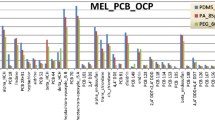Abstract
In this study, we developed a novel method for the collection of gaseous and particulate isocyanates in the air using di-n-butylamine (DBA)-coated glass fiber filters and a cation-exchange column (GFF_SCX-DBA) sampler. Our method showed acceptable linearity, accuracy, and precision in the analysis of eleven kinds of isocyanates (ICA, MIC, EIC, PIC, PHI, 1,6-HDI, 2,4-TDI, 2,6-TDI, trans-IPDI, cis-IPDI, and 4,4′-MDI). And, some of them were detected in the air at the plant manufacturing isocyanates and spray polyurethane foam. Actually, 2,4-TDI and 2,6-TDI (11,000 ± 6600 and 5800 ± 3500 ng/m3, respectively) were detected at much higher levels than others at the plant manufacturing isocyanates, and the levels of these isocyanates were comparable with those obtained by using the commercial sampler. Furthermore, PHI and 4,4′-MDI (5800 ± 470 and 3500 ± 1100 ng/m3, respectively) were detected at a relatively higher concentration than the others in the place of spray polyurethane foam. Through this study, we realized that the concentration of isocyanates in various working places could be analyzed using our GFF_SCX-DBA sampler. This method makes it possible to perform a rapid and simplified extraction operation in a shorter time than in the commercial sampler by combining the GFF and SCX samplers.




Similar content being viewed by others
References
Mishra PK, Panwar H, Bhargava A, Gorantla VR, Jain SK, Banerjee S, et al. Isocyanates induces DNA damage, apoptosis, oxidative stress, and inflammation in cultured human lymphocytes. J Biochem Mol Toxicol. 2008;22:429–40.
Karol MH. Respiratory effects of inhaled isocyanates. Crit Rev Toxicol. 1986;16:349–79.
US EPA, TDI and related compounds Action Plan. April. 2011.
Ott MG, Diller WF, Jolly AT. Respiratory effects of toluene diisocyanate in the workplace: a discussion of exposure-response relationships. Crit Rev Toxicol. 2003;33:1–59.
Bernstein JA. Overview of diisocyanate occupational asthma. Toxicology. 1996;111:181–9.
Redlich CA, Karol MH. Diisocyanate asthma: clinical aspects and immunopathogenesis. Int. Immunopharmacol. 2002;2:213–24.
Cleet C. Isocyanates in flexible polyurethane foams. Bull Environmen Contam Toxicol. 2005;74:1–3.
California Office of Environmental Health Hazard Assessment (CA OEHHA). Proposed revised reference exposure levels for toluene diisocyanate and methylene diphenyl diisocyanate. https://oehha.ca.gov/air/document-news/proposed-reference-exposure-levels-toluene-diisocyanate-and-methylene-diphenyl (accessed February 26, 2019)
ISO17734-1.Determination of organonitrogen compounds in air using liquid chromatography and mass spectrometry—part 1: isocyanates using dibutylamine derivatives 2013.
Bekki K, Uchiyama S, Kunugita N. Analysis of isocyanates in indoor dust. Anal Bioanal Chem. 2018;410:4247–51.
Marand A, Karlsson D, Dalene M, Skarping G. Solvent-free sampling with di-n-butylamine for monitoring of isocyanates in air. J Environ Monit. 2005;7:335–43.
Brady JM, Crisp TA, Collier S, Kuwayama T, Forestieri SD, Perraud V, et al. Real-time emission factor measurements of isocyanic acid from light duty gasoline vehicles. Environ Sci Technol. 2014;48:11405–12.
Acknowledgments
We are grateful to Koichi Wada, Kazuo Taniguchi, and Hisao Kokeguchi for their helpful support for the field sampling and discussions from the standpoint of a specialist on isocyanates. And we are grateful to Shinichi Teruyama and Kohei Wada for their helpful support for the field sampling.
Funding
This work was supported by a grant from the Japanese Ministry of Education and Science.
Author information
Authors and Affiliations
Corresponding author
Ethics declarations
Conflict of interest
The authors declare that they have no conflict of interest.
Additional information
Publisher’s note
Springer Nature remains neutral with regard to jurisdictional claims in published maps and institutional affiliations.
Rights and permissions
About this article
Cite this article
Bekki, K., Uchiyama, S. & Kunugita, N. A novel analytical method for simple and low-cost detection of isocyanates in ambient air. Anal Bioanal Chem 412, 103–111 (2020). https://doi.org/10.1007/s00216-019-02210-5
Received:
Revised:
Accepted:
Published:
Issue Date:
DOI: https://doi.org/10.1007/s00216-019-02210-5




